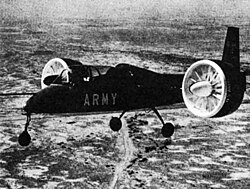Doak VZ-4
| Doak VZ-4DA | |
|---|---|

|
|
| Type: | VTOL convertible aircraft |
| Design country: | |
| Manufacturer: |
Doak Aircraft Company |
| First flight: |
February 25, 1958 |
| Commissioning: |
- |
| Production time: |
- |
| Number of pieces: |
1 |
The Doak VZ-4DA (manufacturer name: Model 16, DA stood for Doak) was an experimental VTOL - convertible aircraft of the US manufacturer Doak Aircraft Company from the late 1950s. Only one example was built with the USAF / Army serial number 56-6942. The VZ-4 was the first aircraft to use the concept of tilting propellers for vertical take-off and landing.
history
Doak received the contract to build a prototype on April 10, 1956 from the US Army Transportation Research and Engineering Command . Ground tests began in February 1958 at Torrance Airport near Los Angeles and comprised 32 hours in a test bench and 18 hours of tethered hovering and taxiing tests. After testing was completed in June 1958, the machine was dismantled, subjected to a detailed inspection and then transferred to Edwards Air Force Base in October . Here the aircraft completed a further 50 hours of flight, which also included complete transitions from hovering to level flight at an altitude of up to 1830 m. The US Army then removed the Doak 16 and brought it to NASA Langley Station . It stayed there until 1972 before it was permanently exhibited in the US Army's Transportation Command Museum in Fort Eustis, Virginia.
construction
The two crew members sat one behind the other. The middle decker had a conventional tail unit and a fixed nose wheel landing gear . The fuselage was a welded lattice tube construction, which was clad with molded fiberglass from the cockpit to the bow tip. The special thing about the design were the two ducted propellers on the wing tips. The rear fuselage area was planked with thin aluminum, while the self-supporting wing and tail surfaces were all-metal constructions. In order to keep the development costs as low as possible, many parts were used from already proven samples. B. the chassis of a Cessna 182 , the seats of an F-51 Mustang and the adjustment of the propellers was done by flap motors of the Lockheed T-33 .
The propeller casing was made of an aluminum alloy with a profile nose of the inlet made of GRP . The eight blades of the propellers were not adjustable and ran at a maximum speed of 4800 rpm. In the front part of the inlet there were 14 adjustable guide surfaces, also made of GRP, which were responsible for the control around the roll axis due to the possibility of thrust control in the hovering state .
The swivel range of the propellers reached from the horizontal setting up to 2 ° backwards in order to compensate for the thrust generated by the turbine exhaust gases. The propellers were driven by a shaft that ran through the wing in about 1/4 of the profile depth. The Lycoming T53 - shaft turbine (initially was a Vorserienausführung YT-53 incorporated) was housed in the fuselage beneath the wing root and worked first on a single aluminum shaft having a diameter of 10 cm and then through a transfer case on two 3.8 cm thick steel shafts. The smaller waves ran in about a quarter of the profile depth through the wings and transferred their power to the two propellers. There were no additional control devices and no automatic position control.
Technical specifications
| Parameter | Data |
|---|---|
| crew | 2 |
| length | 9.75 m |
| span | 7.75 m (including ducted propeller) |
| height | 3.0 m |
Propeller casing diameter |
outside: 1.52 m inside: 1.21 m |
| Wing area | 8.73 m² |
| Empty mass | 900 kg |
| Max. Takeoff mass (vertical) | 1170–1443 kg (depending on the level of development) |
| Top speed | 370 km / h (estimated) |
| Service ceiling | 1830 m (hovering) |
| Range | 370 km |
| Engines | 1 × Lycoming YT53 with 625 kW |
See also
Web links
- Comprehensive historical information on aviastar.org (accessed December 26, 2010)
- Photos of a complete transition on afwing.com (accessed December 26, 2010)
